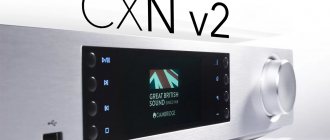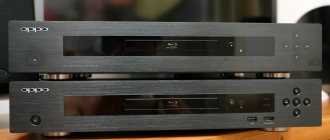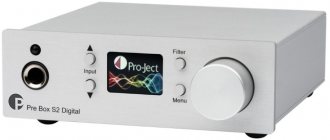Pro-Ject has earned such a strong reputation as a “vinyl” company that no matter what component of the brand catches your eye, the first thing that comes to mind is turntables and related equipment. In our case, the situation is further complicated by the fact that in appearance the Stream Box S2 Ultra can hardly be distinguished from a pair of phono preamps, also part of the S2 family. Meanwhile, this device has absolutely nothing to do with records. But otherwise, its functionality is so extensive that it can fit into setups of a wide variety of formats and purposes.
In my opinion, the official Russian-language name “network player” is not entirely suitable for our today’s hero and can even confuse an inexperienced music lover. But on the other hand, shouldn’t we just call it a “streaming box”? So we’ll still focus on the “player”, but with reservations.
The specificity of the device is that it does not have its own DAC and works exclusively in conjunction with an external converter. This, in fact, was the main idea of the developers - to create an advanced interface that can provide your high-quality, but, so to speak, uncommunicative DAC with the ability to work with digital streams of almost any origin and transmission method.
For clarity, I will list the main features of the Stream Box S2 Ultra. It is able to play files from USB drives and servers on the local network, can work via the UPnP and DLNA protocols, as well as via Bluetooth or AirPlay, receive Internet radio or act as a client for the Tidal and Spotify streaming services. Recently, official information appeared that it can also work with Qobuz, but I have not checked.
The player is very compact, but there is even room on the rear panel for an RJ-45 network interface
The box is capable of transmitting PCM digital streams with a resolution of up to 32 bit/352.8 kHz or DSD up to DSD256 to an external DAC. An important point is that if you correctly understand the settings, the output stream will be output in Bit-Perfect mode, that is, our universal interface will acquire a high degree of musical transparency.
A lot in a little
Like all branded Pro-Ject microcomponents, the small box taken out of the packaging immediately caused cognitive dissonance: in reality it turned out to be even smaller than one could imagine from pictures on the Internet. The second (in order of occurrence, but not in brightness) feeling is the amazing quality of the assembly. Both the front panel and the four-sided monolithic casing are very carefully cut from thick-walled aluminum profile. There are two finishing options: matte polished with a natural silver texture or black tinting.
Thick aluminum walls are pierced with many ventilation holes - inside is a powerful 4-core processor
The facade is decorated stylishly and minimalistically. In addition to the USB 2.0 port, it houses a pair of small buttons (also aluminum) and three almost invisible holes with indicator LEDs hidden behind them. The rear panel, on the contrary, is packed almost to capacity. It contained: an RJ-45 LAN port, a connector for a Wi-Fi antenna, an HDMI video output and three more USB ports.
One of them, like the front one, is designed for connecting external drives and/or a keyboard with a mouse, the second is for an external DAC, and the third, in USB Mini format, is for connecting an external digital source in Detox mode, that is, clearing the transit signal from interference and interference.
Review of the ProJect Stream Box DSA network microsystem: Decent sound
After listening to the composition Swahililand by jazz pianist Ahmad Jamal, you will understand that the built-in digital amplifier is quite capable of floor-standing speakers, at least neither the purity nor the coherence of playback suffers, although the power supply limits the energy of a powerful bass line. But the rest of the range - from rapid piano passages to sparkling cymbals - impresses with its clarity and detail. You'd be hard-pressed to find anything this confident and smooth sounding, even at double the price.
Behind the back
1. Although Stream Box DSA supports wireless networking, we recommend using a wired connection whenever possible, especially if your collection contains music with a resolution greater than 24/96.
2. The device does not have a power plug - the power supply is located in a separate case of quite impressive size. You'll have to find a place for him.
3. An additional USB connector allows you to connect a hard drive, leaving the front one free for portable media.
It is important that high clarity of performance is achieved regardless of whether you listen to files of regular 16/44.1 or high resolution 24/96, or 24/192 - a fact, it seems to us, pleasant for the owner of a budget device and for non-mainstream users home system. A wonderful recording of Bach's Motets performed by a group led by Rene Jacobs exists in our music library in both versions - in both versions the soloists' voices and instruments sound equally transparent and detailed.
Box Control app (Android, iOS)
Price: Free
The application interface, like the device itself, looks simple, but it is easy to work with. At least for devices with small screens, the sleek design is welcome. But for tablets the application should be different, and then it turns out that there is no full-screen version for the iPad. But in the iOS application, everything works quite quickly and clearly, which cannot be said about Android: there either switching from the media server to another input does not occur, or the album image is not updated. Yes, and the letter scrolling is moving somewhere. On the iPhone, everything is scrolled at the speed with which the server manages to load pictures. The application on both platforms allows you to adjust the volume and switch all available inputs, which is quite convenient, since it allows you to do without a remote control, and among the current functions, only rewinding within a track is not implemented.
It remains to be added that neither the digital nor the analogue inputs disappoint. In general, here is a device that can be called successful in all respects.
Price: $2000
Pros: Excellent sound quality; support 24/192 and pause-free playback
Cons: Inconvenient front panel controls; The application for Android is not as stable as for iOS; no dedicated iPad app
Verdict: Add a couple of speakers - and an additional client system is ready, and if these are really good speakers, the result will surprise you
The language of numbers
- Power: 40 W (8 ohms), 60 W (4 ohms)
- Formats: MP3, FLAC (up to 24/192), WMA9, AIFF, AAC, ALAC, LPCM (WAV up to 24/192), Ogg Vorbis 1.0, ASX
- Internet radio: vTuner
- Inputs: Coaxial and optical digital, analog RCA (2)
- Outputs: Coaxial digital, analog fixed and variable level
- Speaker outputs: 1 pair
- Remote control:Yes
- Dimensions (H×W×D):7×21×23 cm
- Weight:2.9 kg
Malinka
Now let's try to look under the hood of our minicar. Surely attentive readers in the description of the miniature audio interface have already been intrigued by the words “keyboard”, “mouse” and “HDMI”. The fact is that in fact we have a real computer in front of us, and it runs on a full-fledged Linux-like operating system.
The quality of the filter circuits of USB interfaces is impressive
More specifically, the Stream Box S2 Ultra is built on the basis of the well-known single-board Raspberry Pi system. But don’t think that Pro-Ject engineers simply took a universal platform, packaged it in a presentable metal box, wrote a software player and put it up for sale at a price that’s not even trivial. The motherboard here is a completely original design, and the Raspberry Pi computing module based on a 4-core Broadcom ARM processor is simply installed on its internal connector.
The Raspberry Pi processor module is hidden under the largest heatsink
The power supply is switching, it is made in the form of a socket plug, but, unlike standard penny boxes, it is made of high-quality hard plastic and is equipped with a set of securely fastened “plugs” of different national standards.











